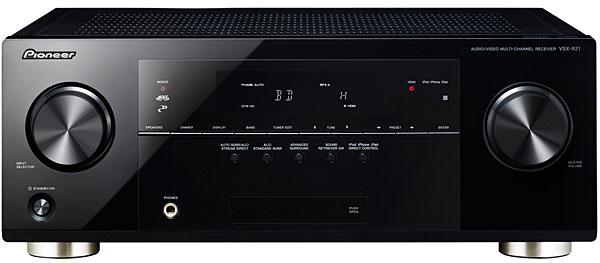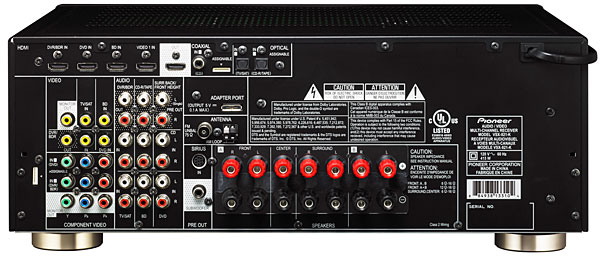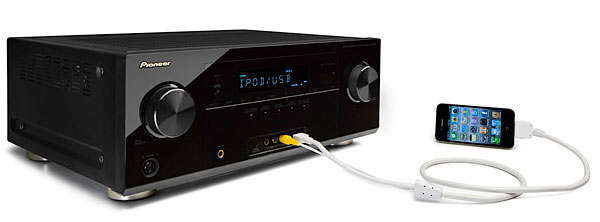Yamaha thought that a single position auto setup program was great too, but the results sounded like crap due to their poor choice of a 7 or 10 band parametric equalizer. To make things worse if you ran the auto setup from precisely the same position using a tripod with dual levelers you would get different results every single time. Does Pioneer's auto setup have this problem too? My old Denon AVR-788 receiver cost $350 for a brand new one and it had Audyssey MultEQ (6 measurement positions). Some may argue that the Denon AVR-788 didn't have support for Blu-Ray audio formats, but this is not an important feature for any budget receiver to have. Just about any budget Blu-Ray player currently being sold can convert the newer audio formats into a PCM audio format that is identical in every way to the original soundtrack.
Pioneer VSX-821 A/V Receiver

This entry-level A/V receiver is a small investment that gets you into the new 3D landscape. It's powerful enough for a small to moderate-sized room, it provides essential surround codecs for the latest movie soundtracks, and it offers quick setup with Pioneer's exclusive auto-calibration system. While it does offer an onscreen display, giving it some points beyond even lower-priced AVRs, it doesn't output the OSD via HDMI. Bluetooth compatibility and a USB port provides some additional functionality and accommodation for wireless headphones and portable media devices.
Features
On the face of it, the Pioneer VSX-821 has all the features you might need, especially in an AVR selling for well under $400. It delivers a respectable 110 watts to each of five channels and is 3D-ready.
Unlike pricier AVRs, the VSX-821 doesn't provide a whole slew of surround codecs, but it certainly provides the most important ones, such as Dolby TrueHD and DTS-HD Master Audio, which the unit automatically detects and decodes when your BD player is set to bitstream. It also provides DTS Neo:6 (though you won't see it in the spec sheet), Dolby Digital Plus, and Dolby Pro Logic IIz. There are also nine DSP (digital signal processing) surround modes you can use on stereo sources, though I found the surround delays to be too extreme for my tastes.

The four HDMI inputs are passthrough only—the AVR does not perform any deinterlacing, scaling, or other video processing. A USB port lets you connect Apple iPods, iPhones, and even iPads for playback of stored media such as songs and videos. A supplied cable plugs into the AVR's front-panel USB port, and the other end attaches to the Apple device's standard 32-pin jack. Splitting off from the USB connector is a composite-video jack (RCA) that plugs into one of the AVR's composite inputs. You can also connect an Android phone/tablet via USB, but it only supports audio, not video.
Using the optional AS-BT200 or AS-BT100 Bluetooth adapter, you can pair the VSX-821 with a variety of Bluetooth devices, such as headphones and portable media players.
The main thing that holds this AVR back is the analog-only onscreen display. I'll provide more details in the Setup section.
 Ergonomics
Ergonomics
The front fascia is plastic, but the glossy ebony black provides a rich and sophisticated look. While the unit is lighter than more-expensive models, the chassis appears to be reinforced in a way that other lower-priced AVRs are not. It has a solid and substantial feel. The rear panel is laid out well and is less cluttered than pricier AVRs with more features and channels.
The front-panel display is easy to read, and the buttons are easily identified. The remote won't take long to learn, though some of the buttons are quite small, such as the tiny Setup button. Moreover, some buttons have dual functions requiring the use of a Shift key. There is no backlight, so you'll have to become adept at finding key functions such as inputs and volume by feel in the dark.
Setup
From a physical standpoint, setup was far more pleasing with speaker binding posts on all channels, rather than a mix of binding posts and spring terminals found on less-expensive models. However, there always seems to be a big BUT with these lower-end products.
With the Pioneer VSX-821, it's the OSD (onscreen display), which is not displayed via HDMI, only the composite and component video outputs. This required an additional connection from the component or composite output on the AVR to a corresponding input on the TV; I used a component connection.
As a result, the only way to see the onscreen setup menu, including auto-calibration, was to switch the TV input to component, then access the setup menu on the AVR. This felt like a real throwback from another age, but I suppose it helps cut costs. If you're like me and only have HDMI source devices, you don't want to be switching to a different TV input just to see the AVR's OSD.
Pioneer's exclusive MCACC (Multi-Channel ACoustic Calibration) auto-calibration system is incorporated into the VSX-821. I found it to be simpler than other auto-calibration systems I've used, mainly because it only calibrates for a single listening position. Audyssey, a well-know third-party auto-calibration system, is found on several other manufacturers' AVRs, and it calibrates two to six positions, promising everyone in the room optimum sound. However, Pioneer believes you can only accurately calibrate the "sweet spot" for one position at a time.
While this model only provides enough memory for one calibration setting, higher-end Pioneer AVRs offer multiple memory settings for different positions in the room. For instance, you can have two different setups for sitting squarely in front of the video display or lounging in a recliner off to the side of the room. Each setting insures you get the best possible surround field wherever you sit, but it is not extended out to include an entire group of people by calibrating for multiple points.
MCACC does have one thing in common with other auto-calibration systems—it makes setup much faster and generally more accurate than a manual adjustment. That said, if you want to tweak the automatic adjustment, there are manual settings for speaker size, level, distance, and subwoofer crossover frequency. I suspect that once the setting is locked into memory, most folks won't want to make any further adjustments.
For auto calibration, connect the supplied mic to the front-panel jack and follow the onscreen prompts. It's nice to see this user-friendly feature make its way down to entry-level AVRs.

In addition to the five pairs of speaker binding posts for the main system, there two more pairs for speakers in another room or perhaps for a separate pair of speakers in the same room for listening to 2-channel music. However, the AVR can play only one set of speakers at a time, either the 5.1 system or the stereo "B" pair.
Performance
The VSX-821's overall audio performance was more than acceptable, and it handled relatively high volume levels well. There were some missing sonic nuances that are present with my mid-priced Onkyo TX-NR609 AVR, such as greater depth, increased dynamic range, and a more delicate sonic signature. That said, I don't think anyone is expecting audiophile performance at this price point, and the Pioneer VSX-821 is a solid performer. While it didn't exhibit a preponderance of bass, I found the overall sonic signature to be slightly heavier and darker than the Onkyo.
I preferred the Stream Direct mode because it plays the same number of channels as the medium sends. If it's stereo, I get stereo; if it's a Blu-ray soundtrack, the AVR will deliver the proper discrete soundtrack without any additional processing.
The included USB cable lets you connect an Apple iDevice, but the video signal is split off to a composite connector, which significantly compromises video quality. This doesn't make much difference with SD content, but HD images are seriously downgraded.
If you don't have a home network, this cable is the only way to display content from an iDevice. However, if you have a home network or plan to set one up, you might want to consider the $99 Apple TV. With the latest iOS5 and Apple's Airplay feature, you can wirelessly connect your iDevices to your video display to stream specific content or mirror the screen of your iDevice. Streaming matches the content's resolution, so you won't be downconverting any HD content.
The unit's analog-only OSD is the main reason I didn't give it a Top Picks designation. Still, if this AVR fits your needs and budget in all other respects, it's a fine product for the money. I just think that with a slightly higher budget, there are products representing an even greater value, including other Pioneer AVRs.
- Log in or register to post comments


So I purchased the VSX-521-K which I assume is identical sound to this one. My problem is combined with my Tannoy speakers I find it a little hard, bright and edgy. Seems to over emphasize grain in broadcasts. At times it does not feel very impactfull as well. You describe the Onkyo 609 as having greater depth and a more delicate sound signature, would this possibly translate into a cleaner and more refined sound I may be looking for?
























































